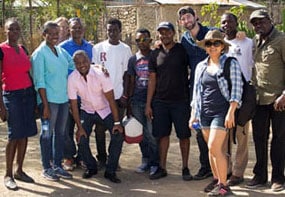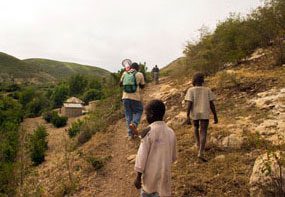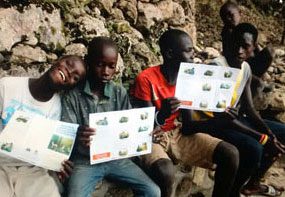Rabies Takes Toll on the Most Vulnerable in Haiti
Cuc Tran, PhD, MPH, joined CDC’s Division of High Consequence Pathogens and Pathology (DHCPP) Rabies Unit in 2015 as one of five new Epidemic Intelligence Service (EIS) officers. Hearing about her first epidemiological investigation experience, one might say the EIS officers are “thrown in the pool to learn how to swim”. Tran’s first Epi-Aid case was in November 2015 in Haiti where a little girl died from rabies. Haiti is one of five remaining countries in the Western Hemisphere where canine rabies is still endemic.
“Rabies is a huge problem there, mainly due to a large proportion of free-roaming dogs being unvaccinated and limited knowledge about the disease,” says Tran.
Shortly after CDC conducted a training for local veterinary agents about recognizing the signs of rabies in October, one of the trainees realized he’d seen a probable case recently and reported it. CDC was contacted to help with the investigation. The affected village was a 50-minute-long ride via a 4-wheel drive from the main paved road. One Haitian colleague said this remote area is only accessible with a motorcycle or 4-wheel drive, and only if it doesn’t rain. Approximately 4,000 people live in the area and they call it “Platfon Mode”—the flat place that bites—because life is difficult there. They also didn’t have access to clean water.

EIS officer Cuc Tran (third from the right) and OC Hubert fellow Maxwell Kligerman (behind Tran) with the team in Haiti.
“Not only was it was my first time leading an Epi-Aid, we were there when the results of the presidential election were announced. There was a lot of political unrest and violent encounters in the streets,” remembers Tran. “To get around Port-au-Prince for site visits, we were driven in armored vehicles and had security guards. It was quite scary, especially since I was also responsible for the safety of our local team and an OC Hubert fellow Maxwell Kligerman who was with me. A couple of times we had to postpone our trip and wait in the hotel for things to calm down.”
After leaving Port-au-Prince, the team saw how big of a problem rabies is and how it’s impacting the people who have the burden at the national level.
While we were investigating the death, there was a dog that attacked 10 people.” The dog was tested and found to be positive for rabies. Our team identified all the bite victims and worked with officials to make sure there was enough post-exposure prophylaxis for everyone, despite a shortage in that area.”
“I think it’s very important to raise awareness about rabies and dog vaccination,” says Tran. The team brought educational materials, a comic book designed by a famous comic book writer for school children, and they also used a generator to power our PowerPoint presentations when educating the community about rabies. The community was very supportive and wanted to be more knowledgeable about the risks.

Typical Haitian countryside. Team of educators hiking to reach remote villages.

Educational comic book featuring a popular character Ti Joel was developed in collaboration with Ministry of Public Health and Population (MSPP) and Ministry of Agriculture, Natural Resources and Rural Development (MARNDR) of Haiti.

Local boys learning about rabies and how to stay safe from rabid dogs from materials brought by Tran and her team.